Extremadura 14-20 April 2015 : Photo-blog part 2
John Muddeman
22/09/2015 15:19:44
Part 2 of a photographic summary of a private 7-day tour to Extremadura during the peak spring period for just about all the wildlife there! This includes a few of the notable flowers, habitats and invertebrates seen, such as Yellow & Mirror Ophrys, Pink Butterfly and Tongue Orchids, Rhinoceros and Scarab Beetles and a 'mixed bag' of other fantastic wildlife.
Posted in: Flora, Other Invertebrates | Extremadura, Madrid | Mainland Spain, Western Spain, Central Spain
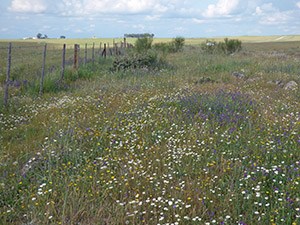 Extremadura - Pseudosteppe in full bloom© John MuddemanIt is all but impossible to capture the true essence of the huge horizons and sweeping 'watercolour' landscapes of Extremadura in spring in a single picture. This is a typical view of the gently rolling pseudosteppe, rich in an abundance of annual mainly spring-flowering grasses and flowers.
Extremadura - Pseudosteppe in full bloom© John MuddemanIt is all but impossible to capture the true essence of the huge horizons and sweeping 'watercolour' landscapes of Extremadura in spring in a single picture. This is a typical view of the gently rolling pseudosteppe, rich in an abundance of annual mainly spring-flowering grasses and flowers.
A succession of colours appears, principally with sheets of yellow, white and purple flowers, throughout the course of the spring, starting often with vast numbers of tiny yellow crucifers, passing through sheets of white Wild Chamomile, especially in the damper hollows, and ending mainly with the purple of the Large Viper's Bugloss. But this is a gross over-simplification and has to be seen to be appreciated!
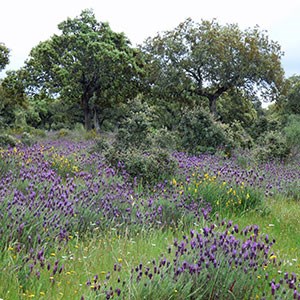 Extremadura - the Western Holm Oak dehesa in flower© John Muddeman
Extremadura - the Western Holm Oak dehesa in flower© John Muddeman
The unique agricultural land-use system of the dehesa -agricultural wood pasture for want of a better definition- is not a simple one. Here French Lavender and Hairy Whin shrubs are colonising where grazing pressure is all but non-existent. In contrast, in areas of deeper soils a poor grain crop is harvested one year, then left fallow for grazing the next, then grazed and foraged by pigs in the third before being cropped again. The trees are periodically pruned for their wood, traditionally to produce charcoal, to stop them growing too high and to promote outward growth to shade the ground and reduce the rate of water loss. This automatically produces a mosaic effect, ideal for a huge variety of microhabitats, plant and animal species.
 Ballast Toadflax
Ballast Toadflax
Linaria spartea© John Muddeman
Typical species include a surprising variety of fabaceous plants, such as annual clovers, vetches and medicks, as well as comon roadside species such as Ballast and Amethyst Toadflaxes, but the variety is enormous, with up to around 90 species per square metre of ground. Of course, given the vast areas with almost identical sandy substrate and environmental conditions over much of lowland Cáceres, the overall diversity is not that high compared to say a mountainous limestone area, but on a fine scale is quite remarkable.
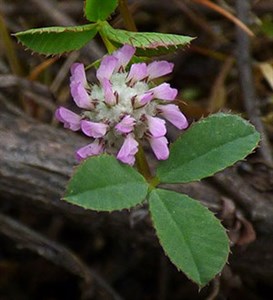 Whorled flower arrangement of the tiny
Whorled flower arrangement of the tiny
Clustered Clover
Trifolium glomeratum© John Muddeman
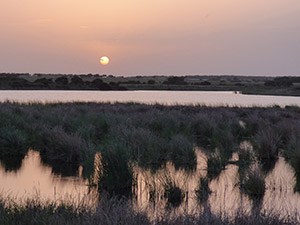 Extremadura - Sunset over the Embalse de Arrocampo© John Muddeman
Extremadura - Sunset over the Embalse de Arrocampo© John Muddeman
Modern habitats include a huge number of man-made waterbodies and associated wetlands. While large permanent wetlands are very much not part of the natural scene in the region, despite a very few natural endorrheic pools of enormous conservation value, the proliferation of reservoirs, including two of the largest in Europe, provides the welcome spin-off of a far greater bird diversity in particular. The cooling waters for the Almaraz Nuclear Power Station are constantly maintained high and have facilitated the formation the largest single stand of emergent vegetation in the region, rich in aquatic birds, including all of Spain's breeding bitterns, herons and egrets, Purple Swamphen, Savi's Warbler, Bearded Reedling...
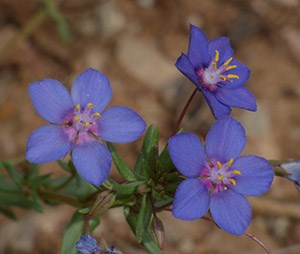 Small clumps of the eye-catching Blue Pimpernel
Small clumps of the eye-catching Blue Pimpernel
thrive on basic soils in a few places
Anagallis monelli© John Muddeman
With most of Extremadura geologically being ancient granitic or of acidic metamorphic rock, the rare outcrops of basic limestone or chalk provide a marked change and house a completely different suite of plants. Orchids abound in these areas, such as on the Almaraz outcrop, largely now under management as an orchid reserve, and with a visitors centre in the N end of the town, but many other interesting species are present too.
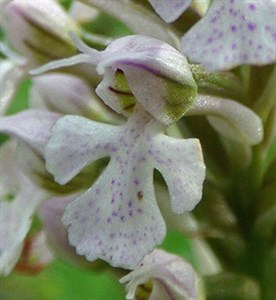 Conical or Spanish Milky Orchid
Conical or Spanish Milky Orchid
Orchis conica© John Muddeman
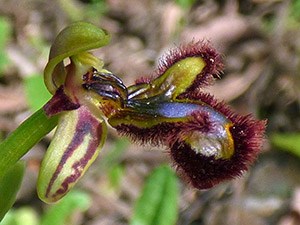 The exquisite Mirror Ophrys is quite common
The exquisite Mirror Ophrys is quite common
Ophrys vernixia© John Muddeman
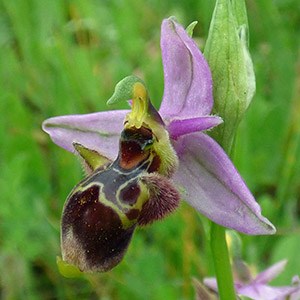 The much taller Woodcock Ophrys
The much taller Woodcock Ophrys
Ophrys scolopax© John Muddeman
 And the beautiful Yellow Ophrys
And the beautiful Yellow Ophrys
Ophrys lutea© John Muddeman
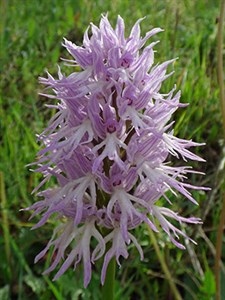 The sometimes abundant Naked Man
The sometimes abundant Naked Man
Orchid
Orchis italica© John Muddeman 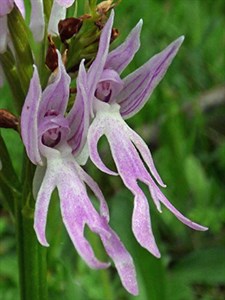 Detail of individual Naked Man
Detail of individual Naked Man
Orchid flowers
Orchis italica© John Muddeman
The relative isolation of these sites, such as at Almaraz has even allowed for the evolution of the 'almaracensis' hypercolourous form of the Bee Ophrys, though this flowers a little later in the season, when the great majority of the other species are over, and I've yet to see it.
.
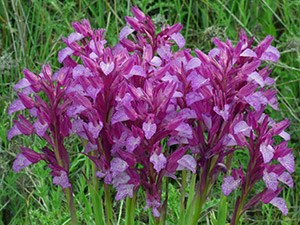 Pink Butterfly Orchids
Pink Butterfly Orchids
Orchis papilionacea© John Muddeman
This incredible clump of Pink Butterfly Orchids was actually at a different site further south in the region, in the Province of Badajoz, despite also occurring scattered in small number in Cáceres Province too. Despite preferring basic soils, it can grow in more typically acid sites too, perhaps where there are other specific minerals permitting its establishment. This particular location houses an absolute bonanza of plants and sometimes the timing of the visit is just right!
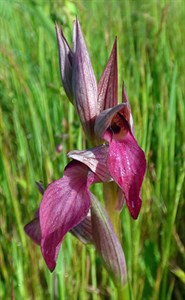 A typical Tongue Orchid from
A typical Tongue Orchid from
Extremadura
Serapias lingua© John Muddeman 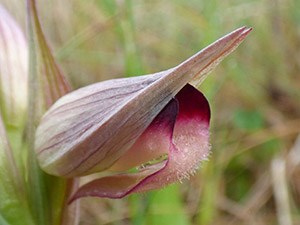 An atypical Extremaduran Tongue Orchid with
An atypical Extremaduran Tongue Orchid with
reflexed labellum!
Serapias sp.© John Muddeman
Tongue orchids are found more widely in winter-wet hollows on the acidic soils, sometimes forming swathes across damp meadows, especially in the N of the region. They also come in a perplexing variety of sizes, shapes and colours. Indeed the variation in size, shape and colour of the flowers and plants, even within one or two large colonies can be bewildering, and added to this the complexity of shifting taxonomy, and the recognition, or not, of an endemic species or two within the region, makes identification even harder.
The variety of invertebrates associated with the wealth of flora also peaks in early spring in lowland Extremadura. (The mountains are rather different of course, being at their best up to 2 months later).
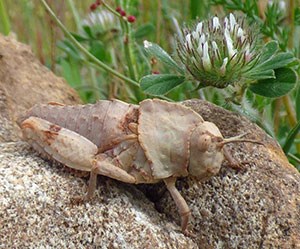 Thumping great grasshopper nymph!
Thumping great grasshopper nymph!
Acrididae© John Muddeman
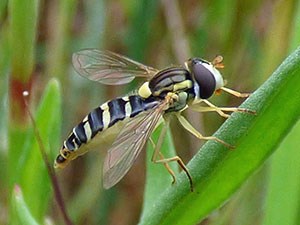 A gorgeous nicely posing hoverfly!
A gorgeous nicely posing hoverfly!
Syrphidae© John Muddeman
 A colourful jumping spider
A colourful jumping spider
Salticidae© John Muddeman
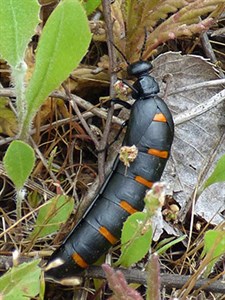 Oil Beetle
Oil Beetle
Berberomeloe majalis© John Muddeman
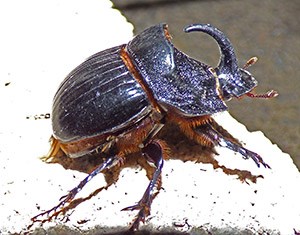 A superb Rhinoceros Beetle, despite
A superb Rhinoceros Beetle, despite
being overexposed by flash at night
Copris hispanus© John Muddeman
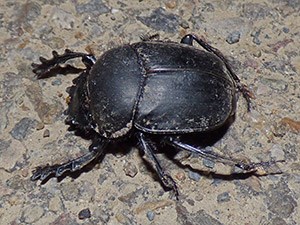 A BIG Scarab Beetle - no wonder the Egyptians
A BIG Scarab Beetle - no wonder the Egyptians
revered them when they crash around in flight at night!
Scarabaeus ?typhon© John Muddeman
Read more blog posts